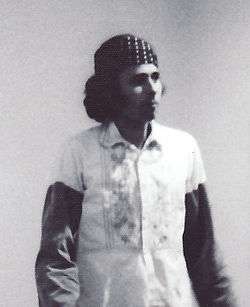Robert de la Rocha
| Robert de la Rocha | |
|---|---|
|
Beto de la Rocha (1974) During Los Four exhibition installation at LACMA | |
| Born |
Robert Isaac de la Rocha November 26, 1937[1] Wilmar, California[2] |
| Alma mater | California State University, Long Beach |
| Known for | father of Zack de la Rocha |
| Spouse(s) | Olivia Lorryne Carter (1961-1976), divorced[3][4] |
Robert Isaac "Beto" de la Rocha (born November 26, 1937)[1] is an American painter, graphic artist, and muralist. He was part of the Chicano art collective Los Four for a few years. De la Rocha was also influential in reestablishing the traditional Mexican celebration of the Day of the Dead in Los Angeles.
Biography
Robert Isaac de la Rocha was born on November 26, 1937 in Wilmar, California[1][2] to Mexican American parents, Isaac de la Rocha Beltrán (September 29, 1910 in Cananea, Mexico - October 10, 1985 in Los Angeles, California)[5][6] and Cecilia Torres Cañedo (May 25, 1914 in Mexico - December 28, 1994 in Los Angeles, California),[6] of Sephardi Jewish converso origin. He earned his Master's of Fine Arts at California State University, Long Beach.
Career
In 1973, he joined the influential Chicano art collective Los Four. The group, composed of Carlos Almaraz, Frank E. Romero, Gilbert "Magu" Luján, and de la Rocha, was responsible for numerous murals and public art installations in the Los Angeles area. According to Luján, he and de la Rocha emphasized "indigenous and local" aspects of Chicano art, while the other two members were more interested in the European tradition.[7] The group was also one of the first to draw mainstream attention to Chicano art, exhibiting at the Los Angeles County Museum of Art in 1974.[8] According to Judithe Hernández, the first female member of Los Four, de la Rocha was also a "brilliant printmaker",[9] much whose imagery was drawn from "his [very fragile] mental state".[9]
My World
After a few years with the group, he suffered a mental breakdown and destroyed his paintings. According to Almaraz, "he left the group under very, very terrible circumstances. He ended up going on 40-day fast and ended up at the psychiatric ward at the L.A. County Hospital, and came down with various illnesses dealing with the fast, and never really recovered. The last I had heard was that he was burning his work and basically denouncing art as being an act of the devil and not an act of God."[10] During this difficult time, he divorced his wife, left his job as a fine-arts instructor at East Los Angeles Community College and moved into his father's Lincoln Heights house. He went into seclusion for years, reading the Bible all day and rejecting art.[11]
Day of the dead
De la Rocha was also influential in reestablishing the traditional Mexican celebration of the Day of the Dead in Los Angeles, when he, along with Chicano artist Gronk and a few others, led a procession from Evergreen Cemetery up First Street in East Los Angeles. Gilbert Luján later said that de la Rocha "should be given credit for initiating this process—almost single-handedly. And what he did, he didn’t get funding or he didn’t ask permission from anybody, he just went and did it." [7] According to The American Prospect, he was also the art editor of the United Farm Workers publication El Malcriado.[12] In 1974, de la Rocha, along with the other founding members of Los Four, was featured in a documentary entitled Los Four/Murals of Aztlan.[13] In 1999, de la Rocha had a joint showing with Los Angeles artist John Zender at La Luz gallery in Long Beach, California[14]
Family
He was married to the anthropologist Olivia Lorryne Carter (born October 8, 1941 in Los Angeles, California)[1] on November 23, 1961 in Imperial, California,[3] whom he divorced in January 1976 in Orange, California.[4] They are the parents of Rage Against the Machine vocalist and lyricist Zack de la Rocha (born January 12, 1970 in Long Beach, California).[12]
References
- 1 2 3 4 California, Birth Index, 1905-1995
- 1 2 Library of Congress Subject Heading authority
- 1 2 California, Marriage Index, 1960-1985
- 1 2 California, Divorce Index, 1966-1984
- ↑ Social Security Death Index Number 563-05-0937
- 1 2 California, Death Index, 1940-1997
- 1 2 "Oral history interview with Gilberto Sanchez Luján, 1997 Nov. 7-17, Archives of American Art, Smithsonian Institution". Retrieved 29 July 2011.
- ↑ Smithsonian Archives of American Art
- 1 2 "Oral history interview with Judithe Hernández, 1998 Mar. 28, Archives of American Art, Smithsonian Institution". Retrieved 29 July 2011.
- ↑ "Oral history interview with Carlos Almaraz, 1986 Feb. 6-1987 Jan. 29, Archives of American Art, Smithsonian Institution". Retrieved 29 July 2011.
- ↑ "My World : He destroyed his art and began a 20-year journey of solitude and soul-searching. But now Beto de la Rocha wants to create again". Los Angeles Times. Retrieved 29 April 2014.
- 1 2 Greif, Mark (2000-01-17). "Revolution Number 9". American Prospect. Retrieved 2007-02-18.
- ↑ "Los Four/Murals of Aztlan (imdb entry)". 1974. Retrieved 29 July 2011.
- ↑ "John Zender Biography". Retrieved 29 July 2011.
